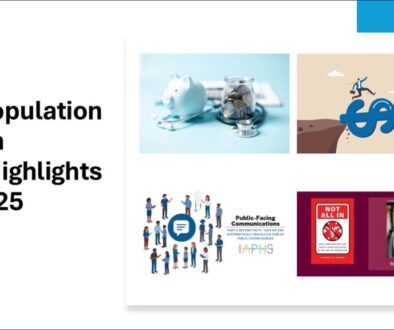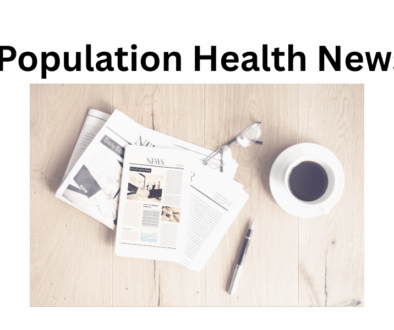Deliberative Dialogue and Decision-Making about U.S. Population Health Challenges: A Pipe Dream or a Possibility?
Erika BlacksherTo describe the United States as deeply divided no longer captures the scope or urgency of our predicament. Increasing numbers of Americans now endorse political violence as a legitimate means to achieve one’s goals.[1] Some believe a civil war is next.[2]
Violence has been directed not only at the nation’s political institutions and public servants in response to the contentious elections of 2016 and 2020, but also toward public health and healthcare professionals who have served on the frontlines of the COVID-19 pandemic. In this context, it may seem brazen or naïve to suggest that people diverse by race, place, class, and political orientation can come together to learn, talk, and decide together about how to address some of the nation’s most pressing population health challenges. But that is precisely what a new project aims to do.
With funding from County Health Rankings & Roadmaps (CHR&R), a program of the Robert Wood Johnson Foundation, Dr. Erika Blacksher is leading a research team, supported by expert advisors, to create a democratic deliberation toolkit. In its proof-of-concept phase, the project aims to learn whether good deliberative conditions can disrupt everyday reasoning habits, short-circuit stereotypes, and cultivate population health dialogues that are more curious, inclusive, and characterized by mutual concern and trust.
What is democratic deliberation?
Democratic deliberation convenes people with diverse perspectives in reasoned dialogue about value-laden questions in search of collective solutions.[3],[4] Empiric evaluations have shown it can yield informed, considered, and public-spirited discussions.[5],[6],[7],[8],[9] A controlled trial has shown that it increases knowledge among participants, regardless of education level, race, or ethnicity, and is especially valued by racial minorities and people with lower levels of educational attainment.[10],[11] Democratic deliberation has been used around the globe to gather public input on contentious issues, even in deeply divided societies that have experienced sectarian violence and civil war[12],[13]. Although deliberation has gained traction in the U.S. health sector and bioethics,[14] few have focused on the poor state of the nation’s health and health inequalities.[15],[16],[17],[18]
How do we talk about population health and health inequalities?
One of the project’s most fundamental challenges is how to talk about the nation’s population health challenges. A basic tenet of democratic deliberation is non-partisan framing.[19] The information (e.g., briefing materials, expert presentations, case studies) needs to be inclusive and balanced; the questions need to not lead deliberants one way or the other. Ample science points to many communication challenges.[20],[21],[22],20,21,22 Some people may reject as erroneous or biased the very premises (e.g., health equity), frameworks (e.g., structural racism), and findings of population health science. Left-leaning and right-leaning people tend to prefer different phrases and metaphors to describe health issues, e.g., Democrats are amenable to “systems”; Republicans to “journeys.” Some words may activate partisan reactions, including ideas integral to population health such as “social determinants.” Fortunately, the research also points to potential strategies for effectively conveying information about population health across our many divides.
What are the next steps?
Such challenges, and the project’s goals, have guided every aspect of the design. For example, the deliberation will allow plenty of time for formal and informal conversation and connection, and overnight reflection—2 days, 14 hours total. Longer deliberations have been shown to be more effective in respects central to the project’s goals.[23] The facilitation team will be multiracial. Case studies will feature a range of population health challenges that have differential impacts by race, socioeconomic status, and gender, and framed within the nation’s overall poor health [24]. Recruitment will oversample groups that experience excess poor health and early death. These are just a few of the many decisions that need to be made in designing a deliberative study.
Whether or not good deliberative conditions can enable people from all walks of life to learn and talk together with mutual respect and shared purpose remains to be seen. The deliberations will not be piloted until 2023, once we secure funding. But that we need to find a way to talk about the nation’s significant health inequalities, declining life expectancy, and overall poor health is an ethical, policy, and political imperative.
References
[1] Rachel Kleinfeld. The Rise in Political Violence in the United States and Damage to Our Democracy. Testimony before the Select Committee to Investigate the January 6th Attack on the United States Capitol. March 31, 2022. https://carnegieendowment.org/2022/03/31/rise-in-political-violence-in-united-states-and-damage-to-our-democracy-pub-87584
[2] Rodrigo Pérez Ortega. Half of Americans anticipate a U.S. civil war soon, survey finds. ScienceInsider. July 19, 2022. Available at: https://www.science.org/content/article/half-of-americans-anticipate-a-us-civil-war-soon-survey-finds
[3] Burkhalter, S., Gastil, J., & Kelshaw, T. (2002). A Conceptual Definition and Theoretical Model of Public Deliberation in Small Face-To-Face Groups. Communication Theory, 12(4), 398–422. https://doi.org/10.1111/j.1468-2885.2002.tb00276.x
[4] Blacksher, E., Diebel, A., Forest, P.-G., Goold, S. D., & Abelson, J. (2012). What Is Public Deliberation? Hastings Center Report, 42(2), 14–16. https://doi.org/10.1002/hast.26
[5] Davies, C. (2011). Participatory Citizens – Desirable? Possible? Practical? Sociology, 45(6), 1134–1139.
[6] Carpini, M. X. D., Cook, F. L., & Jacobs, L. R. (2004). Public Deliberation, Discursive Participation, and Citizen Engagement: A Review of the Empirical Literature. Annual Review of Political Science, 7(1), 315–344. https://doi.org/10.1146/annurev.polisci.7.121003.091630
[7] Abelson, J., Forest, P.-G., Eyles, J., Smith, P., Martin, E., & Gauvin, F.-P. (2003). Deliberations about deliberative methods: Issues in the design and evaluation of public participation processes. Social Science & Medicine, 57(2), 239–251. https://doi.org/10.1016/S0277-9536(02)00343-X
[8] Goold, S. D., Biddle, A. K., Klipp, G., Hall, C. N., & Danis, M. (2005). Choosing Healthplans All Together: A Deliberative Exercise for Allocating Limited Health Care Resources. Journal of Health Politics, Policy and Law, 30(4), 563–602. https://doi.org/10.1215/03616878-30-4-563
[9] Gastil, J., Bacci, C., & Dollinger, M. (2020). Is Deliberation Neutral? Patterns of Attitude Change During “The Deliberative PollsTM.” Journal of Deliberative Democracy, 6(2), Article 2. https://doi.org/10.16997/jdd.107
[10] Carman KL, Maurer M, Mallery C, Wang G, Garfinkel S, Richmond J, Gilmore D, Windham A, Yang M, Mangrum R, Ginsburg M, Sofaer S, Fernandez J, Gold M, Pathak-Sen E, Davies T, Siu A, Fishkin J, Rosenberg M, Fratto A. (2014). Community Forum Deliberative Methods Demonstration: Evaluating Effectiveness and Eliciting Public Views on Use of Evidence. (Prepared by the American Institutes for Research under Contract No. 290-2010-00005.) AHRQ Publication No. 14(15)-EHC007-EF. Rockville, MD: Agency for Healthcare Research and Quality. www.effectivehealthcare.ahrq.gov.
[11] Wang, G., Gold, M., Siegel, J., Sofaer, S., Yang, M., Mallery, C., & Carman, K. L. (2015). Deliberation: Obtaining Informed Input from a Diverse Public. Journal of Health Care for the Poor and Underserved, 26(1), 223–242. https://doi.org/10.1353/hpu.2015.0021
[12] Luskin RC, O’Lynn I, Fishkin JS, Russel D. (2014). Deliberating Across Deep Divides. Political Studies 62:116-135.
[13] Ugarriza JE and Nussio E. (2015). There Is No Pill for Deliberation: Explaining Discourse Quality in Post-conflict Communities. Swiss Political Science Review 22(1):145-166.
[14] Abelson J. & Blacksher E. & Li K. & Boesveld S. & Goold S., (2013) “Public Deliberation in Health Policy and Bioethics: Mapping an emerging, interdisciplinary field”, Journal of Public Deliberation 9(1). doi: https://doi.org/10.16997/jdd.157
[15] Pesce, J. E., Kpaduwa, C. S., & Danis, M. (2011). Deliberation to Enhance Awareness of and Prioritize Socioeconomic Interventions for Health. Social Science & Medicine (1982), 72(5), 789–797. https://doi.org/10.1016/j.socscimed.2011.01.002
[16] Scherer, M., Kamler, A., Weiss, L., Blacksher, E., Jeavons, J., & Gold, M. R. (2022). Using Public Deliberation to Set Priorities: The Case of COVID-19 Vaccine Access in New York City. Journal of Public Health Management and Practice: JPHMP, 28(1), 86–94. https://doi.org/10.1097/PHH.0000000000001471
[17] Subica, A. M., & Brown, B. J. (2020). Addressing Health Disparities Through Deliberative Methods: Citizens’ Panels for Health Equity. American Journal of Public Health, 110(2), 166–173. https://doi.org/10.2105/AJPH.2019.305450
[18] Asada Y, Urquhart R, Brown M, Warner G, McNally M, Murphy A. (2020). Troutville: Where People Discuss Fairness Issues. Canadian Journal of Bioethics 3(1):70-82.
[19] Friedman, W. (2007). Reframing “Framing.” Center for Advances in Public Engagement, 1, 1–5.
[20] Robert, S. A., Booske, B. C., Rigby, E., & Rohan, A. M. (2008). Public views on determinants of health, interventions to improve health, and priorities for government. WMJ : official publication of the State Medical Society of Wisconsin, 107(3), 124–130.
[21] Robert Wood Johnson Foundation, Carger, E. & Westen, D. (2010). A New Way to Talk about the Social Determinants of Health. https://www.rwjf.org/en/library/research/2010/01/a-new-way-to-talk-about-the-social-determinants-of-health.html
19 Niederdeppe, J., Bu, Q. L., Borah, P., Kindig, D. A., & Robert, S. A. (2008). Message Design Strategies to Raise Public Awareness of Social Determinants of Health and Population Health Disparities. The Milbank Quarterly, 86(3), 481–513. https://doi.org/10.1111/j.1468-0009.2008.00530.x
20 Iyengar, S. (1990). Framing Responsibility for Political Issues: The Case of Poverty. Political Behavior, 12(1), 19–40.
21 Iyengar, S. (1996). Framing Responsibility for Political Issues. The ANNALS of the American Academy of Political and Social Science, 546(1), 59–70. https://doi.org/10.1177/0002716296546001006
22 Lundell, H., Niederdeppe, J., & Clarke, C. (2013). Public Views About Health Causation, Attributions of Responsibility, and Inequality. Journal of Health Communication, 18(9), 1116–1130. https://doi.org/10.1080/10810730.2013.768724
[23] Carman KL, Maurer M, Mallery C, Wang G, Garfinkel S, Richmond J, Gilmore D, Windham A, Yang M, Mangrum R, Ginsburg M, Sofaer S, Fernandez J, Gold M, Pathak-Sen E, Davies T, Siu A, Fishkin J, Rosenberg M, Fratto A. Community Forum Deliberative Methods Demonstration: Evaluating Effectiveness and Eliciting Public Views on Use of Evidence. (Prepared by the American Institutes for Research under Contract No. 290-2010- 00005.) AHRQ Publication No. 14(15)-EHC007-EF. Rockville, MD: Agency for Healthcare Research and Quality; November 2014.
[24] Woolf, S., & Aron, L. (Eds.). (2013). U.S. Health in International Perspective: Shorter Lives, Poorer Health. The National Academies Press.






All comments will be reviewed and posted if substantive and of general interest to IAPHS readers.